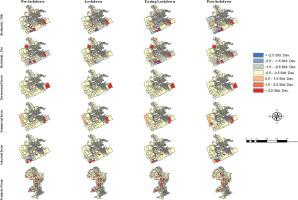Applied Energy ( IF 10.1 ) Pub Date : 2021-09-17 , DOI: 10.1016/j.apenergy.2021.117864 Ammar Abulibdeh 1

|
This study investigates the water – electricity consumption in the context of the COVID-19 pandemic across six socioeconomic sectors. Due to inadequate research on spatial modelling of water – electricity consumption in the context of the COVID-19 pandemic, this study investigated geographical block-level variation in water and electricity consumption in Doha city of Qatar. Spatial analyses were performed to investigate the spatial differences in each sector. Five geospatial techniques in a Geographical Information System (GIS) context were used in the study. Moran’s I, Anselin Local Moran's I, and Getis-Ord statistics tools were used to identify the hot spots and cold spots of water and electricity consumption in each sector. Furthermore, Ordinary Least Square (OLS) and Geographically Weighted Regression (GWR) models were employed to investigate the spatial relationship between water and electricity consumption during the pandemic year. The findings show that there is a distinction in water and electricity consumption at the block level across all sectors and over time. Hot spot and spatial regression analysis reveal spatial and temporal heterogeneities in the study area across the six socioeconomic sectors. The intensity of hot spots of water and electricity consumption are found in the southern and western parts of the city due to high population density and the concentration of the commercial and industrial areas. Furthermore, analyzing the spatiotemporal correlation between the water and electricity consumption across the six sectors shows variation within and between these sectors over space and time. The results show a positive relationship between water and electricity consumption in some blocks and over time of each sector. During the lockdown phase, strong positive correlation between water and electricity consumption have exist in the residential sector due to extra water and electricity footprints in this sector. Conversely, the water and electricity consumption were positively correlated but declined in the industrial and commercial sector due to the curtailment in production, economic activities, and reduction in people’s mobility. Mapping the hot spot blocks and the blocks with high relationship between water and electricity consumption could provide useful insight to decision-makers for targeted interventions.
中文翻译:

卡塔尔多哈市六个社会经济部门 COVID-19 大流行背景下水电消耗的时空分析
本研究调查了六个社会经济部门在 COVID-19 大流行背景下的水电消耗。由于对 COVID-19 大流行背景下的水电消耗空间建模研究不足,本研究调查了卡塔尔多哈市水电消耗的地理块级变化。进行了空间分析以调查每个部门的空间差异。研究中使用了地理信息系统 (GIS) 环境中的五种地理空间技术。Moran's I、Anselin Local Moran's I和 Getis-Ord统计工具被用来确定每个部门的水和电力消耗的热点和冷点。此外,采用普通最小二乘法 (OLS) 和地理加权回归 (GWR) 模型来研究大流行年期间水和电力消耗之间的空间关系。调查结果表明,随着时间的推移,所有部门的区块级别的水和电力消耗都存在差异。热点和空间回归分析揭示了研究区域六个社会经济部门的时空异质性。由于人口密度大、工商业集中,南部和西部地区水耗和用电热点集中。此外,分析六个部门的水和电力消耗之间的时空相关性表明,这些部门内部和之间在空间和时间上存在差异。结果表明,随着时间的推移,某些街区的水和电力消耗之间存在正相关关系。在封锁阶段,由于该部门额外的水和电足迹,住宅部门的水和电力消耗之间存在很强的正相关关系。相反,由于生产和经济活动的减少以及人员流动性的减少,工业和商业部门的水和电力消耗呈正相关但有所下降。











































 京公网安备 11010802027423号
京公网安备 11010802027423号